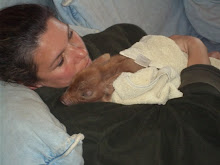
Today started out like any other day. I made my rounds with the hogs. The last hogs I usually feed are Big Daddy and Darla. They are located in the field next to the egg layers. These chickens have access to anywhere on the farm but a bunch will make a bee line right to their hog neighbors at feeding time. They all huddle around, carefully attempting to grab a bite of corn or hog pellets from the feeder pan. I just put the feed in the two pans and started examining Darla. She is due to farrow in about three to four weeks. I looked around for a second and then happened to notice a rooster chasing one of the Black Star hens down the hill.
"Oh for Pete's sake! Can you just leave her alone!!"
There was still some snow and ice on the ground. Maybe that is why the black hen was having a hard time getting away from the rooster. She was trying to get up but still having a hard time. I ran down to see if I could assist and what do I see? A headless chicken. She got too close to Darla's mouth! Chickens still move after they are killed. That's why I thought she was just having a difficult time with the snow.
I grabbed her by the legs and proceeded back up the hill to Darla. Sure enough, right by her bowl, there was the head. How strange. Now here I have this newly killed chicken, but what do I do? I didn't want to waste good meat. Scott was in Fairfax. I definitely could scald and pluck feathers but I didn't know how to eviscerate. My job with the chickens is quality control, bagging and weighing. Tony(our farm partner and champion eviscerator) was at work as well so it looked like it was just going to be me. I did call Tony to get instructions but I needed a visual "how-to". So I checked out You Tube...How to Eviscerate a Chicken. By the way...those of you who do not know what eviscerate means, it is gutting a chicken. Taking out all of the innards(intestines, gizzard, heart, etc.). Joel Salatin had good step by step instructions.
I got a big stock pot filled with water and set it on the stove. When the water temp for scalding was correct(147 degrees is what Scott likes) I started dunking the bird up and down for about a minute. Then I put the chicken in a bucket and went outside to pluck feathers. Back inside to the kitchen sink to attempt eviscerating. Too cold and windy outside. The crop was the size of a baseball. That was easy to get out. I start cutting...eeww it stinks. Back outside where it is cold and windy so the smell can be whisked away. I finish cutting, put my hand inside and everything comes out at once. Hmmm...not so bad. I completed the task at the kitchen sink, washing and doing my famous quality control.
This chicken is what is called a stewing hen. Egg layers only lay efficiently for about two years. Ater that, they are processed for stewing. If you roasted one of these birds in the oven, it would be very tough. An older hen needs to be stewed all day, like in a crockpot. Chicken and dumplings would be great with a stewing hen. A friend of mine said he puts in a crockpot a can of mushroom soup with about a half a can of white wine along with the chicken. It goes great with broccoli and rice. You can't go wrong. The key is slow cooking for a LONG time.
Bon Appetit!


No comments:
Post a Comment